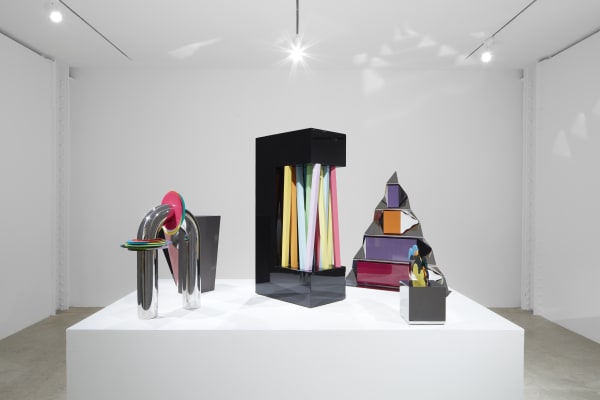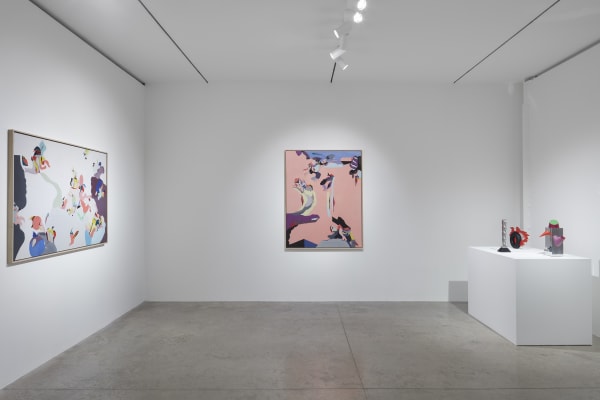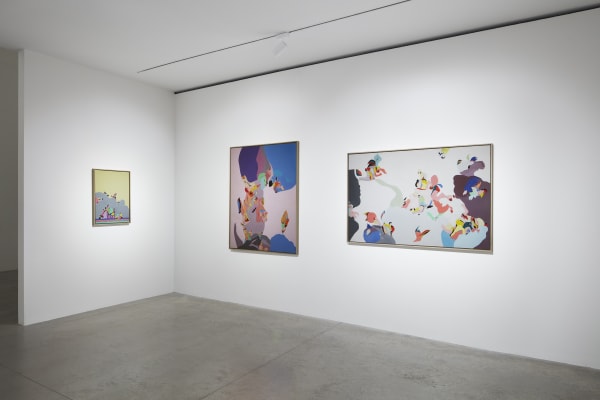Fausta Squatriti: Buster Keaton’s Walk and Early Sculptures: Curated by Margaret Liu Clinton
NEW YORK, NY | albertz benda is pleased to present Fausta Squatriti: Buster Keaton’s Walk and Early Sculptures. These two chronologically overlapping bodies of work, spread across adjacent installations, comprise the artist’s first exhibition in New York since 1969. Each selection isolates key motifs from the artist’s earliest series. The combination of paintings and sculptures offers new audiences a glimpse into the fantastically dynamic investigations, both material and conceptual, that have come to characterize Squatriti’s artistic practice.
Upon entering the first room, visitors will encounter a concise presentation of five small to medium scale steel sculptures (1967–1971) that have been sequestered from a larger series of three-dimensional works. Set in a quincunx formation upon a single plinth, the shiny array is intercut with planes of color to varying degrees of coverage. Just a few halos of color encircle the shiny steel arc of Anelli Passanti (1970) while the dark outer rectangle of Ripieno (1970) is literally stuffed with stalks of bright colors.
Identifying her distinct ability to conjoin mechanical and organic forms, art historian and critic Claudio Cerritelli states: “Any discussion of Squatriti’s sculpture must immediately take into account the combination of industrial and traditional materials (polyester, Plexiglas, lacquer, steel, iron, wood, and copper) in a sculptural idiom that was widespread throughout various movements of the Sixties, ranging from Pop to Minimalism to Program Art to geometric aniconic sculpture.”
As one transitions into the next room, three smaller scale steel sculptures (1967–1971) rest upon a plinth to the viewer’s right. To the left, a single, painted wood, wall sculpture La Passeggiata di Buster Keaton: Bagno d’Aria (Buster Keaton’s Walk, Air Bath), 1966 serves as the formal lynchpin between the sculptures and the neighboring paintings (1965–1967). In this small, theatrical,black diorama the artist has isolated some of the chromatic floating forms that populate and spill forth from Squatriti’s earliest series of paintings, Buster’s Keaton’s Walk.
On the heels of his first encounter with a highly frenetic New York City in 1928, Spanish poet, playwright, and theater director Frederico García Lorca penned El paseo de Buster Keaton. In horrified response, García Lorca re-casts Buster Keaton’s hapless and melancholic character as a sort of readymade who wanders through an absurd series of encounters. Citing her cue from Lorca’s experimental literary bricolage, Squatriti commences a cycle of abstract paintings in various sizes that glance back at Rococo and Surrealism while also presaging Postmodern syncretism. To bring her inspiration for the series full circle, this exhibition marks the first occasion in which La Passeggiata di Buster Keaton (Buster Keaton’s Walk) will be exhibited in New York.
Squatriti’s disciplined approach to synthesizing styles, reframing received formats, and setting disparate histories into dialogue has perhaps eluded viewers accustomed to singular statements. It is precisely the sophistication of her multivalent approach that invigorates this opportunity to encounter her work in the context of today.
ABOUT FAUSTA SQUATRITI
Since the 1960s, Fausta Squatriti (born Milan, 1941) has worked in the fields of painting, sculpture, poetry, fiction, and art criticism. Her work has been exhibited and published internationally.
Select solo exhibitions have taken place at: Galleria dell'Indiano, Milan (1964); Galerie Pierre Lundholm, Stockholm (1968); Kozmopolitan Gallery, New York (1969); Mabat Art Gallery, Tel Aviv (1970); Estudio Actual, Caracas (1970); Galerie Alexander Isolas, Genève (1972); Museo de Art Contemporáneo Jesus Soto, Bolivar City (1975); Galerie Denise René, Paris (1982); Mala Galerije, Ljubljana (1983); Galerie Karin Fesel, Düsseldorf (1987, 1997); The Art Building Commons Gallery, Honolulu (1988, 1994); Museum am Ostwall, Dortmund (2001); Fondazione Mudima, Milan (2001); Moscow Museum of Modern Art, Moscow (2009); Triennale di Milano, Gallerie di Italia Museo d’Arte di Banca Intesa San Paolo and Nuova Galleria Morone (2017); and Galleria Bianconi, Milan (2019). Her works belong to numerous public collections including: the Stedelijk Museum, Amsterdam; the Centre Georges Pompidou, Paris; Musée d’Art Moderne de la Ville de Paris, Paris; the Museum of Modern Art Jesus Soto, Bolivar City; Ciudad Bolivar, the Museo del Novecento, Milan; the Moscow Museum of Modern Art, Moscow; the Moderna Museet, Stockholm; and the Tel Aviv Museum of Art, Tel Aviv.
Alongside her own studio practice, Squatriti collaborated with artist colleagues as the publisher of graphic art and multiples between 1964 and 1986. In 1992, Squatriti founded and ran Kiliagono Magazine with Gaetano Delli Santi. In 2015, she edited Story of a Tapestry and in 2017, she published the collection of poems Olio Santo (2010-2016). As a poet and writer, Fausta Squatriti has published with The Laboratory of the Arts, Giovanni e Vanni Scheiwiller, Manni, Book, Textual, Traces, The Laboratory of Nola, amongst others. She is the author of: La villeggiatura, Sentimental Breviary, Crampi, and La Cana. She has been awarded the Eugenio Montale Prize for The Unpublished (1988) and the Scrivere Donna poetry award (2009). Her most recent poetry collection Forbidden to Enter (2013) was published by La Vita Felice. She lives and works in Milan.
albertz benda extends its gratitude to Jennifer Bacon, Filippo Fossati, Renata Bianconi, Ornella Mignone, and most especially, Fausta Squatriti.




